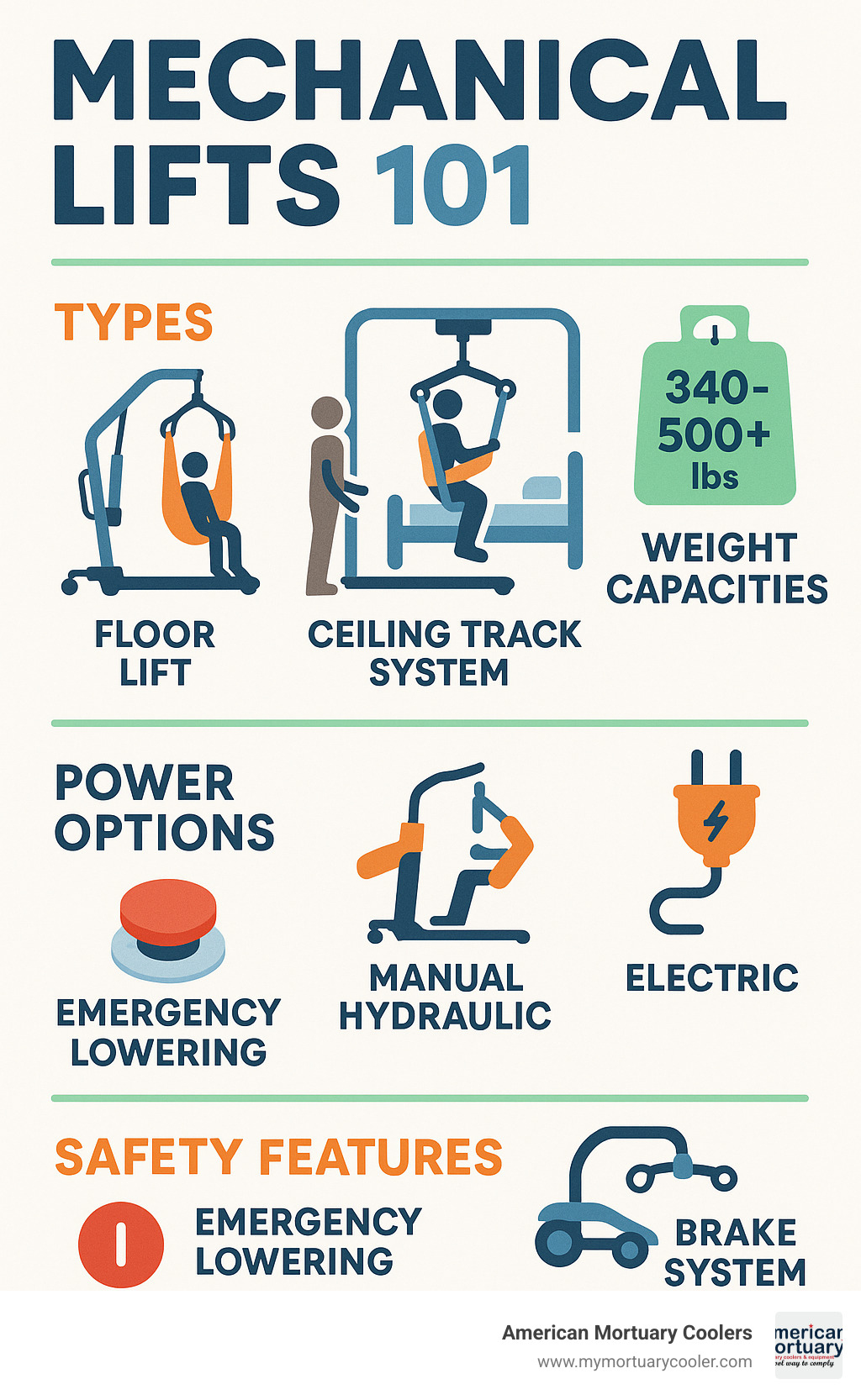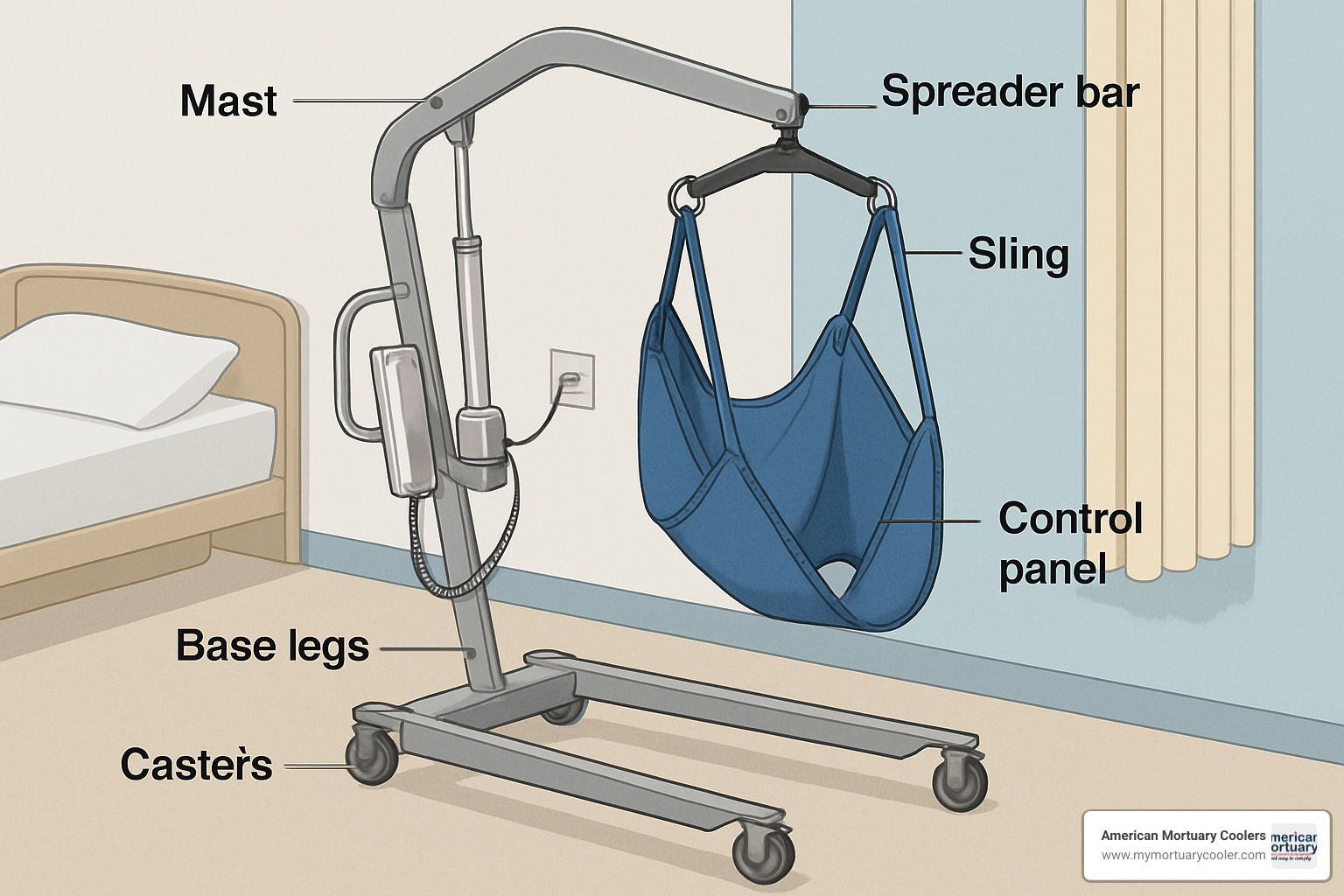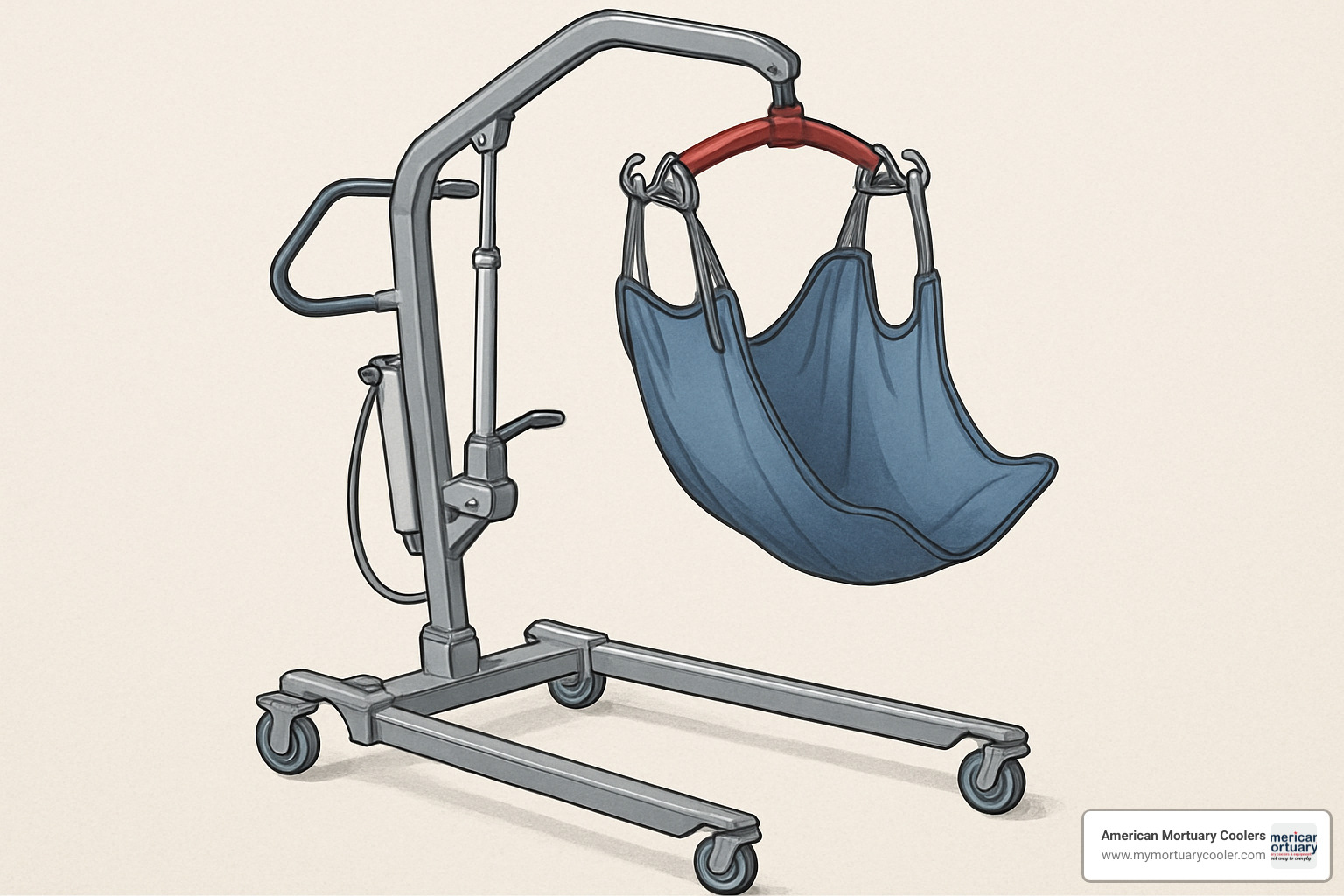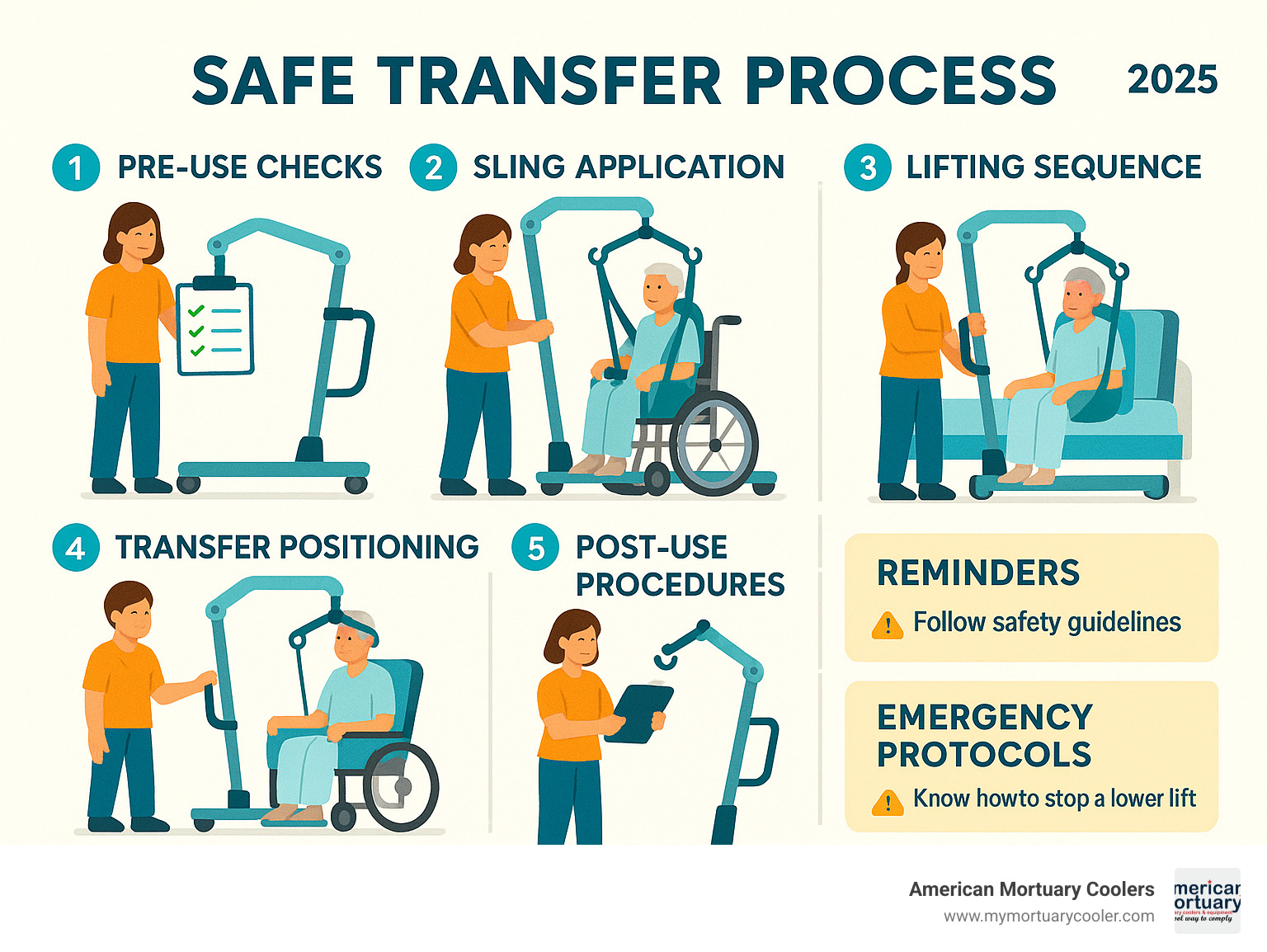Why Mechanical Lifts Are Essential for Safe Patient Care
A mechanical lift is a medical device designed to safely transfer individuals with limited mobility from one position to another, reducing physical strain on caregivers while protecting patients from falls and injuries.
Key Types of Mechanical Lifts:
- Passive Floor Lifts - Full-body slings with hydraulic or electric power (Hoyer-style)
- Active Sit-to-Stand Lifts - Support belts for users with some leg strength
- Overhead/Ceiling Lifts - Track-mounted systems for seamless transfers
- Portable/Folding Lifts - Compact models for travel and tight spaces
Weight Capacities: 340-500+ lbs depending on model Power Options: Manual hydraulic, battery electric, or plug-in electric Common Settings: Hospitals, nursing homes, home care, funeral facilities
If you're transferring independently but have fallen a couple of times on your way from the wheelchair to the bed, and your caregiver's back pain is getting worse, this scenario highlights exactly why mechanical lifts have become essential equipment in healthcare and mortuary settings.
Mechanical lifts benefit both users and caregivers by eliminating manual lifting that causes over 38,000 caregiver injuries annually. Whether you need a $400 manual hydraulic lift for occasional home use or a $12,000 ceiling track system for continuous facility operations, the right lift dramatically improves safety and quality of life.
I'm Mortuary Cooler from American Mortuary Coolers, where we've helped funeral homes nationwide select durable mechanical lift solutions that fit their specific space and budget requirements. Our direct experience with mortuary equipment has shown us how the right lifting technology transforms both patient care and operational efficiency.

Mechanical lift glossary:
What Is a Mechanical Lift and How Does It Work?
Think of a mechanical lift as your strongest assistant that never gets tired or throws out their back. At its heart, it's a transfer device that harnesses the power of hydraulic pressure or electric motors to safely move people who can't support their full body weight.
The magic happens through a simple but brilliant combination: a sling that cradles the person like a gentle hammock, paired with a spreader bar that evenly distributes the lifting forces across their body. No more awkward grabbing under arms or risky manual hoisting.
Instead of asking caregivers to use their backs as human cranes, a mechanical lift redirects all that energy through hydraulic fluid pressure or electric actuators. This means you can smoothly lift a 450-pound individual even if you weigh half that amount.
Floor lifts roll around on wheels and can position themselves next to beds, chairs, or wherever you need them. Ceiling-mounted systems follow permanent tracks overhead, gliding from room to room like they're on invisible highways.
The difference between passive and active lifts is all about teamwork. Passive lifts do all the heavy lifting when someone can't bear any weight, while active models work alongside users who still have some leg strength to contribute.
For detailed coverage criteria and safety standards, Medicare provides Scientific research on patient lifts that covers everything from approval requirements to proper usage guidelines.

Mechanical Lift Basics
Here's a name you might recognize: Hoyer lift. Back in 1955, Ted Hoyer watched his wife struggle with transfers after polio left her with limited mobility. Being the inventive type, he created the first patient lift to make her life easier. Today, "Hoyer" has become the household name for passive floor lifts.
The lifting cycle is surprisingly straightforward once you get the hang of it. You position the lift, apply the sling snugly but comfortably, connect the attachment points, raise the person smoothly, roll to wherever they're going, and lower them safely into place.
Mechanical Lift Components
The mast is your lift's backbone - that vertical support column housing either a hydraulic cylinder or electric actuator. The boom extends horizontally from the mast like a strong arm, supporting the spreader bar where slings attach.
Those base legs aren't just for show. They provide rock-solid stability and often adjust their width to squeeze around beds and wheelchairs. Most models roll on sturdy 5-inch casters with individual brake locks.
Here's a feature you hope you'll never need but will be grateful exists: emergency lowering mechanisms. Manual lifts include pressure-relief valves that let you lower someone safely even if something goes wrong. Electric models go a step further with backup battery systems or manual override cranks that work even during power failures.
Comparing Main Types of Mechanical Lifts
When you're shopping for a mechanical lift, you'll quickly find that not all lifts are created equal. The good news? Each type serves a specific purpose, so understanding your needs will point you toward the right solution.
Manual hydraulic lifts are the workhorses of the industry, costing between $360-$7,200. You'll pump a lever to raise and lower users, which means no batteries to charge or electrical components to maintain. These lifts are reliable, but they do require more physical effort from caregivers.
Powered electric models range from $2,700-$9,500 and take the manual work out of lifting. Just press a button, and the motor does the heavy lifting. Your caregivers will appreciate the reduced strain, especially during frequent transfers throughout the day.
Sit-to-stand lifts cost $800-$12,000 and work beautifully for users who still have some leg strength. These active lifts help people transition from sitting to standing positions while maintaining their independence and dignity.
Ceiling track systems represent the premium option at $8,000-$14,000. Yes, they're expensive, but they transform the entire care environment by eliminating floor obstacles and enabling smoother transfers.
Bariatric models handle users over 500 pounds, while portable designs fold up for transport or storage in smaller spaces. Your choice ultimately depends on user weight, mobility level, care setting, and budget constraints.
| Feature | Manual Hydraulic | Electric Powered |
|---|---|---|
| Price Range | $360-$7,200 | $2,700-$9,500 |
| Power Source | Manual pump | Battery/plug-in |
| Caregiver Effort | Moderate | Minimal |
| Maintenance | Low | Moderate |
Passive Floor Lifts (Hoyer-style)
Passive floor lifts are perfect for users who cannot bear weight on their legs. These mechanical lifts use full-body slings that cradle users from shoulders to buttocks, providing complete support during transfers.
The Invacare Lightweight Hydraulic Patient Lift exemplifies this category beautifully. With its 450-pound capacity and 4.4-star rating from over 500 customers, it's proven reliable in real-world use. The ProHeal Electric Lift steps it up with a 500-pound capacity and earns 4.4 stars from 83 customers.
Spreader bars come in 2-point, 4-point, and 6-point configurations. More attachment points mean weight distributes more evenly across the user's body, but you'll need compatible slings for each system.
These lifts excel at bed-to-chair transfers, toileting assistance, and bathing support. The wide base legs straddle wheelchairs and beds easily, though this design does limit maneuverability in tight spaces. If you're working in cramped quarters, measure twice before ordering.
Active Sit-to-Stand Lifts
Active lifts are game-changers for users who retain some leg strength but need support getting up. They feature knee pads that prevent forward sliding and support belts that wrap securely around the torso during lifting.
Here's how they work: the user places their feet on the lift's platform, grabs the support handles, and the device raises them to standing position. It's like having a mechanical helping hand that promotes independence while maintaining muscle strength through partial weight-bearing exercise.
These lifts work wonderfully for transfers between similar-height surfaces like bed to wheelchair or chair to commode. They're more compact than passive lifts, which makes them easier to maneuver in tight spaces.
The catch? Users need sufficient upper body strength and cognitive ability to follow instructions safely. If someone can't grip the handles securely or understand the transfer process, a passive lift might be the better choice.
Overhead & Ceiling Lifts
Ceiling-mounted systems use permanent tracks installed in the room structure, creating smooth transfer paths without any floor obstacles. Track systems can run straight for single-room use or curve through doorways to connect multiple rooms.
Freestanding gantry lifts provide overhead lifting without permanent installation, though they do require more floor space. The absence of base legs eliminates the positioning challenges you face with traditional floor lifts.
Four-way ceiling lifts enable independent transfers for users with sufficient upper-body strength. This dramatically improves quality of life - imagine being able to move from bed to bathroom without calling for help.
Installation averages $8,000, but these systems transform the entire care environment. No more base legs to steer around, no more lifting strain on caregivers, and no more cluttered floors. The investment pays dividends in reduced injuries and improved care quality.
Choosing the Right Mechanical Lift: Key Features & Considerations
When you're shopping for a mechanical lift, it's easy to get overwhelmed by all the options. But don't worry - we'll walk you through the most important decisions to help you find the perfect fit.
Weight capacity is your starting point, and it's not negotiable. Your lift needs to handle significantly more than the user's current weight - think of it as a safety buffer. Most standard models support 340-450 pounds, while bariatric versions can handle 500-600 pounds or more. It's better to overestimate than find yourself in a dangerous situation later.
The user's specific medical condition plays a huge role in which lift will work best. Someone with a spinal cord injury might need completely different sling support than a person with muscular dystrophy. If you're dealing with a progressive condition, think ahead - you'll want a lift that can adapt as mobility needs change over time.
Home versus facility use makes a big difference in what you should buy. At home, you'll probably want something portable that folds up and tucks away when not needed. Facilities, on the other hand, benefit from heavy-duty models built to handle multiple transfers every single day without breaking down.
If you're considering an electric model, battery range matters more than you might think. Some lifts give you 20+ transfers per charge, while others need plugging in constantly. There's nothing worse than having your lift die mid-transfer because you forgot to charge it.
Don't assume all slings work with all lifts - sling compatibility varies wildly between manufacturers. Make sure your chosen lift works with the sling styles you need, whether that's a basic U-sling or something specialized for showering.
Some nice-to-have features include integrated scales for monitoring weight changes and LED displays that clearly show battery status. These aren't essential, but they can make daily use much more convenient.
For specialized mortuary applications, our More info about lift products guide covers industry-specific requirements and solutions that regular healthcare lifts might not address.
Mechanical Lift Sizing & Weight Limits
Bariatric lifts that support 500+ pounds are engineering marvels, but they come with trade-offs. These heavy-duty models need reinforced frames and much larger slings, which usually means they're less portable and harder to maneuver in tight spaces. The ProHeal Electric Lift does a nice job balancing this - it handles 500 pounds while still being reasonably maneuverable around furniture.
Pediatric applications are usually straightforward since most adult lifts work fine for children. You'll just need appropriately sized slings and need to be extra careful about weight distribution.
Before you fall in love with any particular model, grab a tape measure. Room clearance can make or break your lift choice. Measure doorways, hallway widths, and the space around beds and chairs where you'll be maneuvering. There's nothing more frustrating than getting a lift delivered only to find it won't fit through your bathroom door.
Ceiling height becomes critical if you're considering overhead lifts. Most standard residential ceilings work fine, but vaulted ceilings, low basements, or unusual architectural features might require custom solutions or force you toward a different lift type entirely.
Sling Selection & Accessories
Think of slings as the interface between user and machine - getting this wrong affects both comfort and safety. U-slings provide full-body support for passive transfers and work for most basic needs. Commode slings include strategic openings for toileting, which maintains dignity during bathroom transfers.
The Vive Patient Lift Sling supports 400 pounds and features mesh construction that's perfect for shower transfers - no more worrying about soggy fabric that takes forever to dry.
Repositioning sheets are unsung heroes in the lift world. They help you move someone in bed without doing a full lift cycle, which saves wear and tear on your equipment and reduces the number of times you need to get the whole lift apparatus involved.
Some users need head support attachments, especially if they have limited neck control. Don't overlook this - proper head positioning makes transfers much safer and more comfortable.
Sling sizing follows clothing measurements, with small, medium, large, and extra-large options available. This isn't a place to guess - incorrectly sized slings create pressure points and compromise safety. When in doubt, get a professional fitting. Your local medical equipment dealer can usually help you get this right the first time.

Safe Operation, Maintenance & Training
Operating a mechanical lift safely starts long before you ever touch the power button. Think of it like driving a car - you wouldn't skip checking your mirrors and adjusting your seat, right? The same careful approach applies to lift transfers.
Pre-use safety checks should become second nature. I always tell our customers at American Mortuary Coolers to develop a routine: inspect the sling for any tears or worn spots, test those brake locks, check battery charge levels on electric models, and make sure all connection points are rock-solid.
Here's something that surprises many people - even with a mechanical lift doing the heavy lifting, proper body mechanics still matter. Caregivers should avoid twisting their backs and maintain good posture throughout the transfer process.
The two-person rule remains the gold standard for safe transfers, especially when you're starting out. While some experienced users can operate lifts independently with proper training, having a second person provides an extra layer of safety and confidence.
Battery management might seem boring, but it's absolutely critical for electric lifts. Most models will warn you when power runs low, but why risk it? Establish a routine charging schedule - many facilities plug in their lifts overnight or during shift changes.
Cleaning protocols vary depending on your setting, but the basics remain consistent. Disinfect all surfaces between users, especially in healthcare facilities. Slings need regular washing according to manufacturer specs.
Don't forget about preventive maintenance logs. These simple records help you track service activities and spot potential problems before they become expensive failures.

Mechanical Lift Safety Checklist
Lock those brakes - this is non-negotiable. Both the lift brakes and any brakes on destination equipment like wheelchairs need to be engaged before you start.
Sling loop equality prevents dangerous tilting during lifts. Take a moment to verify both sides are even before raising anyone.
Emergency stop procedures should be practiced until they become automatic. Every caregiver needs to know exactly how to lower a user immediately if something goes wrong.
Clear pathways before moving anyone. Even a small bump or obstacle can destabilize the lift or frighten the person being transferred.
Caregiver Certification & Training
Hands-on practice with experienced instructors builds real confidence and competency. Physical therapists and occupational therapists often provide the most comprehensive training programs.
Competency records aren't just paperwork - they document each caregiver's ability to operate lifts safely. These records protect both the caregiver and the facility by showing proper training was completed.
Annual recertification keeps skills sharp and identifies areas where additional training might help. Technology changes, new safety protocols emerge, and refresher training catches potential problems before they happen.
Costs, Insurance & Top Brands
Let's talk money - because while mechanical lifts are investments in safety and dignity, they're also significant purchases that need to fit your budget.
Manual hydraulic lifts represent the most affordable entry point at $400-$800 for basic home models. These hand-pumped units work reliably for occasional transfers, though they require more physical effort from caregivers. Powered electric versions jump to $2,000-$7,000 depending on features like battery life, weight capacity, and build quality.
Ceiling systems command premium pricing at $8,000+ including installation costs. While that seems steep, facilities using lifts multiple times daily often find the durability and reduced caregiver strain justify the investment over time.
The good news? Medicare covers mechanical lifts as durable medical equipment when physicians prescribe them for specific medical conditions. Medicaid waivers often provide additional coverage for home-based care equipment, making these essential devices accessible to more families.
Leading brands have earned their reputations through years of reliable service. Invacare built its reputation with the popular Lightweight Hydraulic Patient Lift featuring 450-pound capacity. Joerns Hoyer carries the legacy of Ted Hoyer, the original lift inventor. ProHeal specializes in electric models with impressive 500-pound capacity ratings. MAIDeSITe brings innovation with designs like floor-to-stand lifts that bridge active and passive categories.
Our experience at American Mortuary Coolers across Tennessee, Atlanta, Chicago, Columbia, Dallas, Los Angeles, New York, Pittsburgh, and throughout the Midwest, Northeast, Rocky Mountain, Southeast, Southwest, and Pacific regions has shown us something important: investing in quality equipment reduces long-term costs through improved reliability and reduced maintenance needs.
For funeral industry applications, our More info about body lift equipment provides specialized guidance on mortuary lift requirements.
Funding & Reimbursement
Insurance billing involves specific HCPCS codes that classify different lift types. E0630 covers patient lifts, while E0621 applies to slings and accessories. Your physician's prescription must document medical necessity and specify equipment requirements clearly.
Rental versus purchase decisions depend heavily on usage frequency and insurance coverage. Short-term rehabilitation needs often favor rental arrangements, while long-term use makes purchase more economical. Do the math based on your specific situation.
Documentation requirements can seem overwhelming but they're crucial for approval. You'll need physician evaluations, home safety assessments, and caregiver capability assessments. Thorough paperwork increases approval likelihood and speeds reimbursement significantly.
Brand & Model Comparison
Feature matrices help compare specifications across brands objectively. Focus on weight capacity, power source, dimensions, warranty length, and verified customer ratings rather than marketing claims.
Warranty coverage varies dramatically between manufacturers. Some offer basic one-year limited warranties while others provide comprehensive five-year coverage including parts and labor. Factor warranty costs into your total ownership calculation.
Customer ratings from verified purchasers offer invaluable real-world insights into reliability and satisfaction. The Invacare model's 4.4-star rating from 500+ customers demonstrates consistent performance across diverse users. The MAIDeSITe Electric Chair Lift's 4.5 stars from 1,900+ reviews shows impressive broad market acceptance.
The cheapest lift isn't always the most economical choice. A reliable mechanical lift that works consistently for years costs less than a bargain model that breaks down frequently or doesn't meet user needs effectively.
Frequently Asked Questions about Mechanical Lifts
Let's tackle the most common questions we hear from families and facilities considering mechanical lift purchases. These answers come from real conversations with customers across our service areas.
How do I choose the correct sling size?
Think of sling sizing like buying a good jacket - you need the right measurements for comfort and safety. Start by measuring chest circumference, hip width, and torso length from shoulders to buttocks.
Small slings work for users under 120 pounds, medium fits 120-200 pounds, large supports 200-300 pounds, and extra-large handles 300+ pounds. But here's what the size charts don't tell you - body shape matters just as much as weight.
A professional fitting makes all the difference. Occupational therapists can assess whether you need a standard U-sling for general transfers, a commode sling with toileting access, or specialized supports for specific medical conditions.
The right sling should feel snug but not restrictive, with no pressure points or loose areas that could cause sliding during transfers.
Can one caregiver operate a mechanical lift alone?
This question comes up constantly, and the honest answer is it depends on your specific situation. While one person can technically operate most mechanical lifts with proper training, best practices strongly recommend two-person operation for safety.
Here's how it typically works: the primary operator controls the lift while the assistant guides the user and watches for any problems. This teamwork approach catches issues before they become accidents.
Users with good upper-body strength and clear thinking can often help with their own transfers, especially with sit-to-stand lifts. Ceiling systems offer the most independence - some users can transfer completely on their own once they're trained.
Will Medicare cover my mechanical lift purchase?
Medicare Part B does cover patient lifts as durable medical equipment, but you'll need to jump through some hoops first. Your physician must prescribe the lift for a specific medical condition and document why you can't transfer safely without mechanical assistance.
The equipment must come from a Medicare-approved supplier, and you'll pay 20% of the Medicare-approved amount after meeting your annual deductible. Your supplemental insurance might pick up the remaining costs.
Here's a pro tip: get pre-authorization before ordering anything. Work closely with your physician and equipment supplier to make sure all the paperwork is complete and correct. This prevents coverage denials that can delay getting the equipment you need.
Conclusion
Choosing the right mechanical lift can feel overwhelming with all the options available, but it doesn't have to be. Whether you're caring for a loved one at home or managing equipment for a healthcare facility, the right lift transforms daily care from a struggle into something manageable and safe.
We've seen how the right equipment changes everything. A family dealing with multiple daily transfers suddenly finds relief with a $2,000 electric lift. A nursing home reduces caregiver injuries by 80% after installing ceiling track systems. A funeral home improves their service quality with professional-grade lifting equipment that handles every situation with dignity.
The numbers tell the story clearly. Manual lifts starting around $400 work perfectly for occasional home use, while electric models in the $2,000-$7,000 range handle frequent transfers with less caregiver strain. Ceiling systems at $8,000+ represent a significant investment, but they pay for themselves through reduced injuries and improved efficiency.
At American Mortuary Coolers, we've helped facilities across Tennessee and throughout the country find lifting solutions that actually work for their specific needs. Our experience with mortuary equipment has taught us that durability matters more than flashy features, and proper sizing prevents most problems before they start.
The most important factors come down to matching weight capacity to your actual needs, choosing power options that fit your usage patterns, and ensuring your caregivers receive proper training. Insurance coverage through Medicare or Medicaid can significantly reduce costs, but the paperwork requirements need attention to detail.
Your next step should be talking with your healthcare provider about what type of lift makes sense for your situation. They can help with the medical necessity documentation needed for insurance coverage and recommend local suppliers for hands-on demonstrations.
Don't wait until someone gets hurt to make this decision. Back injuries happen in seconds but take months to heal. Falls can change everything in an instant. The right mechanical lift prevents these problems while preserving independence and dignity for everyone involved.
For specialized lifting solutions designed for funeral industry requirements, our team understands the unique challenges you face. Visit our More info about lift solutions page to explore custom options that combine professional reliability with the respectful care your clients deserve.
















